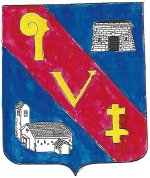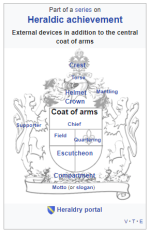Accueil > The Town > History > Origin and organization of the town
Villey le Sec Coat of Arms
par
The arms of Villey le Sec in heraldic depiction is : Azur, on a Bend Gules, three Charges Or, a capital V between a Crosier in the Chief and the Cross of Lorraine in the Base. Two other Charges Argent are also represented, a stone tower in the Chief Sinister and a church in the Base Dexter, both underlined in Sable.
Heraldry is a representation discipline that was developed around the 12th century so Knights in full face helmet and body armour could quickly differentiate themselves on the battlefield.
Here is Villey le Sec arms description in today’s language [1] : Azur (blue), on a Bend Gules (on a diagonal upper left to lower right bright red band), three Charges Or (with on it 3 gold symbols), a capital V between a Crosier in the Chief (in the top part) and the Cross of Lorraine in the Base (in the lower part). Two other Charges Argent (2 other silver symbols) are also represented, a stone tower in the Chief Sinister (top right corner) and a church in the Base Dexter (bottom left corner), both underlined in Sable (black).

Coat of arms design or Blazon in Heraldic : The red diagonal band with the 3 gold symbols reminds the arms of the Duchy of Lorraine with its 3 silver Avalerions or Alerions, (heraldic representation of an eagle with one eye looking left, no beak or claws and wings down), as Villey le Sec once belonged to the Duchy of Lorraine.
Our town was then located on the border of the Duchy and the Toul’s bishop territory that was belonging to France. This explains the capital V between the bishop crosier and the Cross of Lorraine. The blue background was selected as it figured on the Arms of nobles that marked our town history (Hoffelize and Riaucourt). This blue colour was also the colour of the old church sealing, scattered with stars, that was destroyed in 1944 by the Nazi.
The church was rebuilt in 1955 and figures in the lower left corner of the shield (Escutcheon in Heraldic). The tower in the right top corner represents the town fortification built starting 1874.
The original design of the Arms was proposed in 1982 by Jean-Pierre URIOT, on the mayor’s request, Claude Prévôt as he had noticed that none existed for his town. The design was validated in 1984.
[1]


